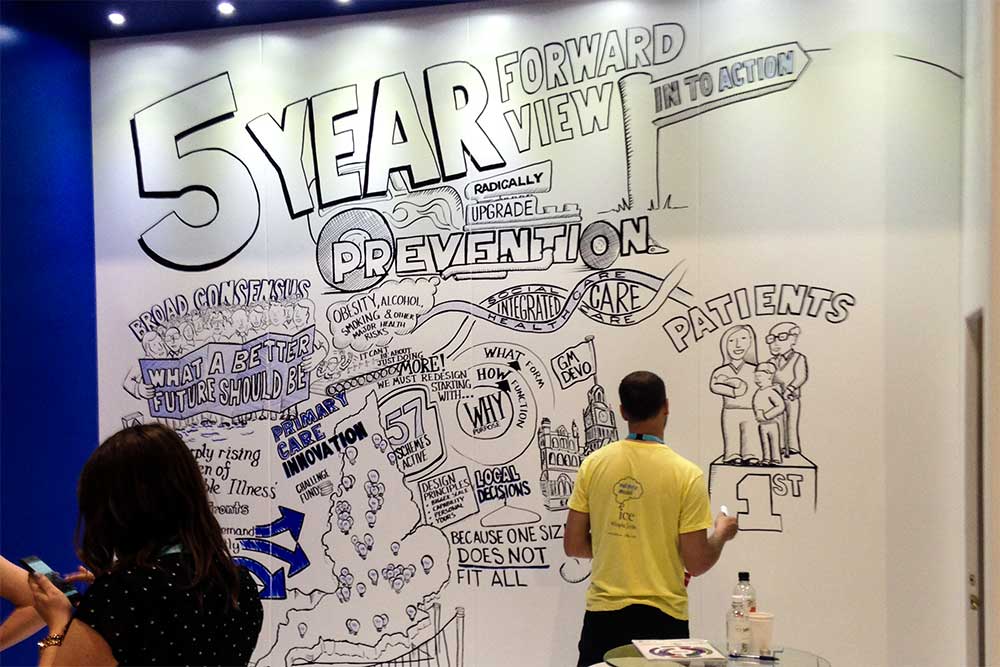Integration was high on the agenda at June’s Commissioning show again this year and with little surprise. The multi-decade long discussion on how to join-up the country’s health and social care system is finally starting to become realistic, or so the government would argue.
Political continuity after the election has seen a commitment from ministers to deliver on NHS England’s Five Year Forward View. At a time of vanguards, political will, and innovation, will integration now really start to happen, and will new models of care actually come to fruition and deliver the promise of joined-up services?
Opinion is certainly divided, especially on the feasibility of the government’s approach.
NHS England quite literally sketched out the apparent means to put the Five Year Forward View into action at Commissioning, embracing a growing theme of physically live graphic recording at major exhibitions and conferences.
No amount of pictorial creativity would however go to convince everyone at the show that sufficient means have been put in place to support the ambitions of the forward view, not least former coalition minister Norman Lamb.
The Liberal Democrat leadership hopeful did not feel that the ‘how’ had been answered sufficiently to bridge the £30bn gap, needed by 2020, to make the forward view happen. Yes, the government had put forward £8bn, but “heroic assumptions” were still being made when it came to achieving the remaining £22bn of efficiency savings, assumptions that Lamb said no-one believed in. He also called for a relaxation of Whitehall “domination” to allow local areas to be able to raise extra cash when needed, and for urgency in creating a pooled health and care budget, which he argued was essential before integration would ever happen.
Lamb was not alone in his scepticism. A show of hands in a room full of several hundred delegates revealed at least half of the health and social care professionals present to have serious doubts about the feasibility of government ambitions – in fact they didn’t believe they would be achieved.
It wasn’t all negative however. Opinion was voiced on what needed to be done, including Saffron Cordery, director of policy and strategy at NHS Providers, who said a bottom up approach had to be adopted for integration to succeed; it could not be top-down.
Evidence of this was already emerging – being revealed at the show itself in fact, where national problems around obstacles like data sharing were being solved at a local level.
Twelve months earlier, David Hodson, the head of information at East and North Hertfordshire Clinical Commissioning Group, used the conference to explain how data was starting to be linked across different care settings locally. A year on, this had moved forward in pioneering ways, fuelled by a collaboration between Hertfordshire’s county council and two CCGs, the conference heard.
Hertfordshire had created a shared intelligence network, where information was being “scrambled”, being made non-identifiable, or pseudonymised. This means that it could be shared across care settings, with significant implications for joined-up planning, modelling and direct interventions across health and care.
Hertfordshire had found an innovative way to mitigate information governance challenges, whilst still maintaining privacy, delegates heard. Confidential information was being de-identified before leaving data controllers, meaning that a lawful flow of data between health and care organisations was now possible.
Crucially, authorised health and care professionals with legitimate direct care relationships could also make the decision to re-identify patients from pseudonymised data, the conference heard. This meant that they could intervene for patients when necessary, and carers and clinicians could make their decisions with a complete view of the care packages that patients receive across different health and social care settings.
It was an important step, one which other geographies were urged to look at. Heroic assumptions at the national level may still exist, leaving important questions to answer. But perhaps the brave innovation happening at the local level may help to the country get there.



